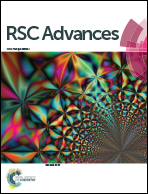Multifunctional lubricant additive based on difluoroboron derivatives of a diphenylamine antioxidant†
Abstract
A metal-free and phosphorus-free novel multifunctional additive (E)-4-((3-(tert-butyl)-2-((difluoroboranyl)oxy)-5-((octylthio)methyl)benzylidene)amino)-N-phenylaniline (difluoroboron derivative 4a) was synthesized and characterized. The results show that its antioxidation and tribological properties are better than those of base oil, diphenylamine and zinc dialkyldithiophosphate (ZDDP), and it can also increase the extreme pressure performance of the base oil. In addition, it can be found that the diphenylamine functional group, boron and fluorine are the main contributors to the excellent antioxidation and antiwear properties of difluoroboron derivative 4a, respectively. Finally, the results of X-ray photoelectron spectroscopy on the worn surfaces reveal that B2O3, Fe2O3, a N-containing organic compound and iron fluoride comprise the boundary films, which effectively improve the difluoroboron derivative 4a's antiwear properties.



 Please wait while we load your content...
Please wait while we load your content...